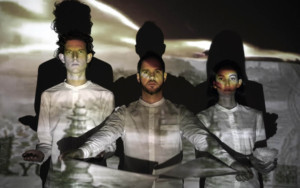Review: ASSEMBLY OPERATION at Space Theatre, Adelaide Festival Centre
 Review by guest writer, Unjay Markiewicz, Saturday 27th October 2018.
Review by guest writer, Unjay Markiewicz, Saturday 27th October 2018.
Assembly Operation, produced by the ensemble, Speak Percussion, seeks to represent aspects of Chinese culture by exploring the sonic potential of three media central to Chinese history: paper, ceramics, and low-fidelity electronics, relating back to associations with the iconic Chinese one yuan note.
Speak Percussion, is a 'new music' ensemble based in Melbourne but with an international reach. Co-founder, artistic director, percussionist, and composer of the present piece, Eugene Ughetti, has been working with Speak Percussion since its inception in 2000. He has also collaborated with international composers, such as Steve Reich and Pierre Boulez.
The ideological lineage of Assembly Operation begins with Pierre Schaeffer's musique concrète and Steve Reich's minimalist and serialist styles of composition. The aim of this approach is deliberately to separate musicality from sound, choosing to explore the media of sound production in the abstract; the medium is the message.
Speak Percussion manages to combine these avant-garde ideals with striking theatrical staging for an immersive audio-visual experience. Assembly Operation opens with the three percussionists (Eugene Ughetti, Speak Percussion's Artistic Associate, Matthias Schack-Arnott, and Kaylie Melville) seated in the dark behind desks or workbenches. There are three rows of three benches, each row set for the respective movement of the composition. Around their feet are clouds of white tissue paper. Under minimalist spotlighting and some up-lighting, they begin to move loops of closely-microphoned paper across their desks, evoking a sound like a flowing stream of water. They add to this with tissue paper being scrunched and then allowed to spring back to form. They continue to add drama and intensity as they begin to tap out polyrhythms on the table, the scenario evoking the isolation within parallel tasks of the contemporary production worker.
The second movement sees the percussionists performing sonic explorations on ceramics, cymbals and cardboard boxes using a variety of implements including knitting needles, wire brushes, and violin bows, while gradually building the sound sources/instruments into a replica of the water pagodas illustrated on the reverse of China's one yuan note. Similarly, the projected scene on the screen behind the performers transitions from pagoda-like forms dissolving in water, to ink marbling on the surface of water, which becomes an abstract version of the bank note's reverse.
For the third movement, the performers move to the back row of tables to play small keyboard synthesisers. This begins in a more lighthearted way with playful references to the 8-bit soundtracks of early computer games, even drawing some laughter from the audience as Schack-Arnott and Melville exchanged electronic ray gun fire. Gradually phasing polyrhythmic patterns evolved into an impressive wall of sound as delay, echo, and flange effects transfigured the naïve electronic sounds of the keyboards. The electronic aesthetic was reflected in the projected image of a grid of colour shifting LEDs and flashing red and green side lighting.
More than just a composition, Assembly Operation presents a collaborative team effort between video artist Cyrus Tang, visual artist Jia Jia Chen, set designer Clare Britton, sound designer Nick Roux, and lighting designer Richard Dinnen, to produce a consistently minimalist piece of performance art.
There were certainly interesting and evocative soundscapes as well as some spectacular visual moments but, somehow, as a whole, the production failed to build to something truly satisfying, arguably being somewhat self-indulgent in parts and, as such, it seemed overly long.
Despite its artistic pedigree, it is arguable that Assembly Operation is unlikely to gain great popular appeal, its purist sonic abstraction refusing to yield even one good tune and eliciting only mild applause from the Adelaide premiere audience.
Reader Reviews

Videos

